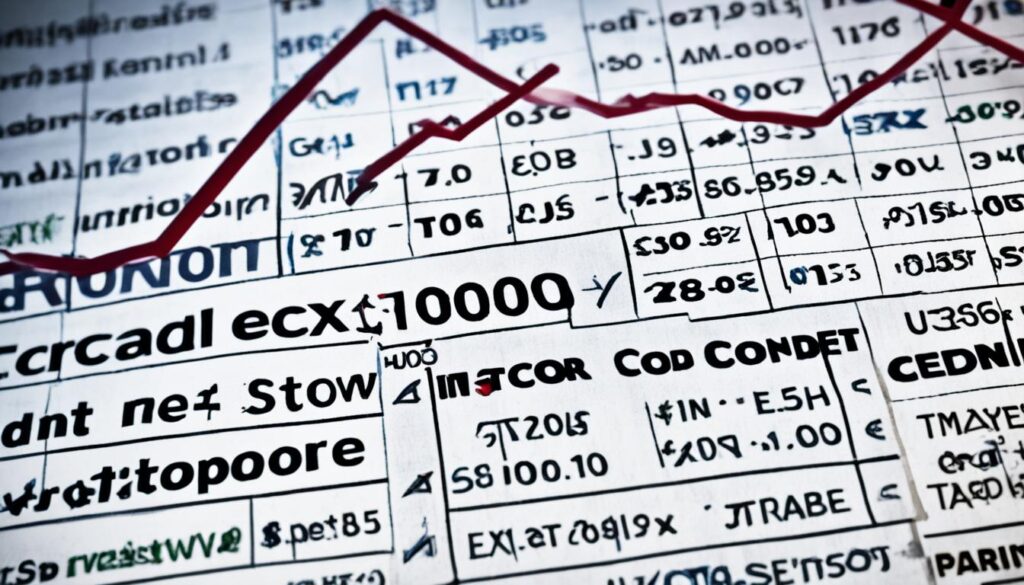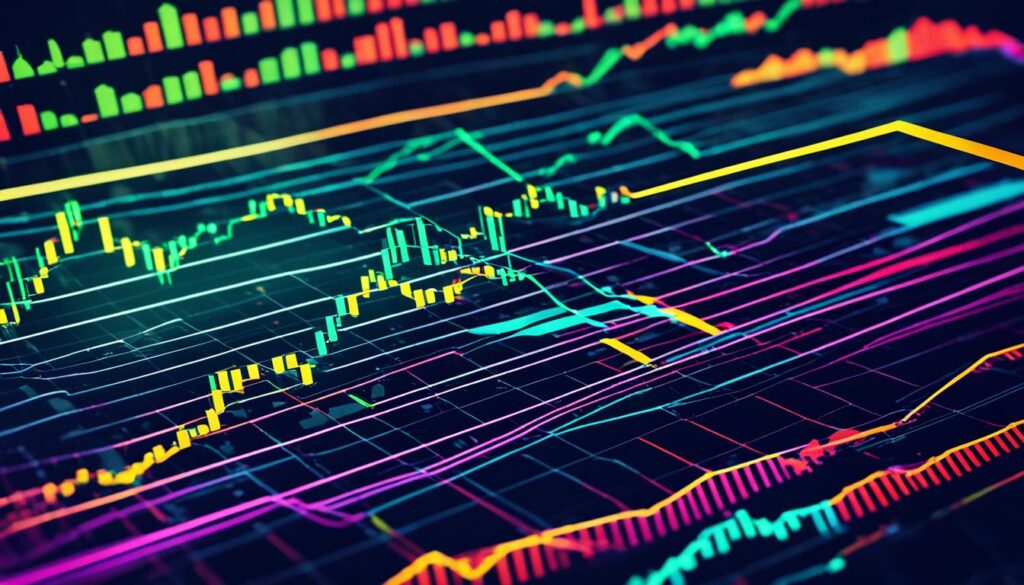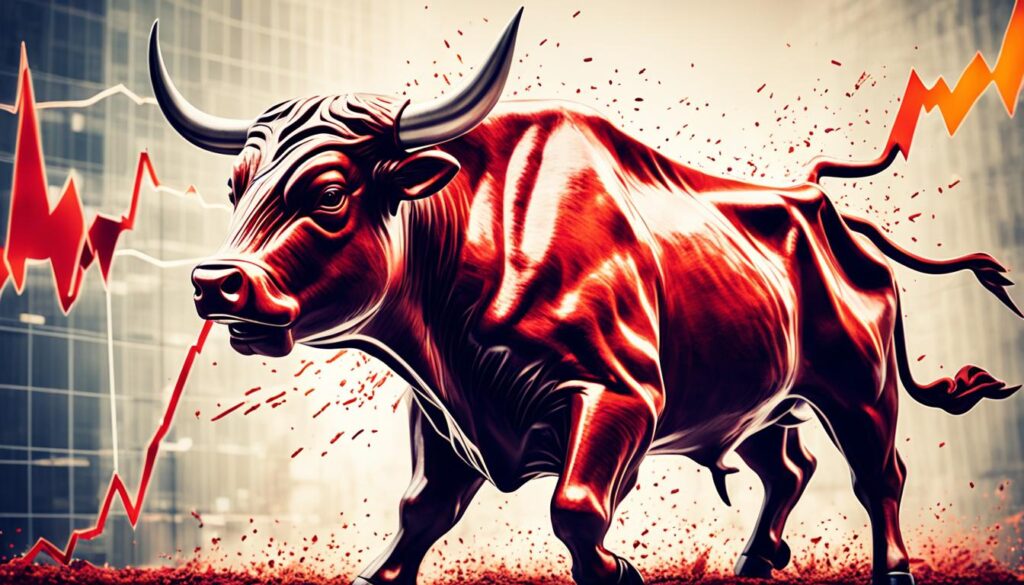What is a Bull Market in Forex Trading?
Did you know the biggest rise in the S&P 500 lasted over 10 years, gaining over 300%? In Forex, a bull market is when currency prices go up. This period shows investors feel confident, and there’s a lot of trading and optimism. A 20% price increase from recent lows starts a bull market.
Forex traders can make a lot by understanding and using bullish trends. It’s hard to predict these changes perfectly because of market and investor reactions. But, using strategies like buy and hold and looking at the market’s technical details can guide traders to make money from these highs.
Key Takeaways
- The threshold for a bull market is typically a 20% rise in prices from recent lows.
- The longest bull market in the S&P 500 lasted from March 2009 to February 2020, with a gain of over 300%.
- Bull markets show investors are very confident and are trading a lot.
- Good trends in Forex trading can mean a big increase in value.
- Knowing how the market thinks and using smart trading plans is key in bull markets.
Understanding a Bull Market
A bull market is a time of growing financial markets. Prices rise, and investors feel good, hoping the trend continues. It’s hard to know it’s a bull market until prices have gone up a lot.
The S&P 500 Index is very important for the U.S. stock market. Since 1942, it’s seen 16 times of growth (bull markets) and 15 falls (bear markets). The longest bull market went from 1988 to 2000, with a huge 582% return. This was helped by the end of the Cold War and the beginning of the Internet Age.
In 2000, the dotcom bubble burst hurt the S&P 500, leading to a 47% fall. Then, in 2022, high inflation pushed the stock market into a bear market, dropping the S&P 500 by 25%. These events show how quickly things can change in financial markets.
In Forex trading, spotting a bull market means seeing prices rise over and over. Investors use different tactics, like buying and holding, hoping prices keep going up.
Bull markets last about twice as long as bear markets. Prices go up more than they go down. This makes investors feel more confident and eager to invest, pushing the market up even more.
| Market Stage | Median Duration | Median Percentage Change |
|---|---|---|
| Bull Market | 42 months | +87% |
| Bear Market | 19 months | -33% |
Knowing about these trends is key to successful investing. This applies to both stock and Forex markets. Handling these market swings well can improve your investments.
Characteristics of a Bull Market in Forex
A bull market in Forex has key traits that make it lively. It shows a lot of trading volume, which points to strong investor interest in higher prices. This makes currency pairs worth more, as people think they will keep going up.
During these times, it’s easier to trade because lots of people are buying and selling. This is called market liquidity. Also, companies give out more money to shareholders when times are good. This shows they are strong and helps investors feel good about the market’s future.

New public company offerings increase because many companies want to take advantage of the positive market vibe. Even though prices usually go up, there can still be short-term drops. But the general direction is usually up.
| Attribute | Bull Market | Bear Market |
|---|---|---|
| Price Trend | Rising | Falling |
| Investor Sentiment | Optimistic | Pessimistic |
| Trading Volume | Higher on up days | Higher on down days |
| Market Liquidity | Improved | Diminished |
Bull markets can last for different lengths of time, as seen in past trends. The longest on record lasted 11 years. The shortest was only two years. On average, they stay strong for almost 4 years. It’s a time when more people want to buy than sell, which keeps prices climbing. This also makes everyone feel positive about the market.
Causes and Factors that Support a Bull Market
Several key factors start and push a bull market forward. They include things like growth in the GDP and fewer people being out of work. When the economy is strong, people feel more confident about investing. This leads to more investments and higher profits for companies. Eventually, this cycle helps the bull market keep going.
Economic Strength
A robust economy is vital for a successful bull market. It features high GDP growth, low unemployment, and steady prices. These aspects show the economy is doing well. As a result, companies make more money and produce more. This progress can keep the bull market up for years. More money and jobs mean more people invest and trade, keeping the market positive.
Investor Confidence
Investors’ trust plays a big role in a bull market. Seeing the economy grow, they feel positive about investing. They become more hopeful about the market’s future. This can lead to more trading and a steady demand for stocks. Such optimism keeps money flowing into assets, pushing their prices up.
Rising Corporate Profits
One big driver of a bull market is when companies make more money. This helps investors believe in the market even more. Businesses earning more get more investment. This cycle continues, benefitting the market. Strong company profits show a good economy. They also help keep investors feeling confident and positive.
- Economic indicators show growing GDP and reducing unemployment.
- High trading volumes and investor optimism mark investor confidence.
- Rising corporate profits bolster economic health and investment appeal.
A bull market is supported by a strong economy, investing trust, and growing company profits. Knowing these key elements helps investors understand the market, including stock and Forex.
Technical Analysis in a Bull Market
Technical analysis is key in a bull market for Forex trading. It looks at past price data and trading volumes. This helps traders see patterns that suggest rising market trends. So, they can make smarter choices and boost their chances of making money when the market goes up.
Chart Patterns to Watch
In a bull market, key chart patterns show where the market might go. These include ascending triangles, flags, and head and shoulders. That’s because these shapes often mean the market will keep going up. It’s a chance for traders to act on these positive signals in the Forex market.

Take the ascending triangle as an example. It has a line that slopes up from the bottom and one that is flat at the top. When the price jumps above the flat line, it suggests the trend is still going up. Flags look like rectangles after prices rise a lot. They could mean a short break before prices start moving up again.
Indicators Signaling Bullish Trends
Indicators are like valuable secret agents in market charts. They include Moving Averages (MA), Relative Strength Index (RSI), and Moving Average Convergence Divergence (MACD). These tools help confirm if the market is likely to go up. They give traders clues about possible future price jumps.
The MACD is one of these indicators. It looks at the relationship of two market price averages. A jump of the MACD line above the signal line might mean the market is turning bullish. The RSI looks at how fast prices have moved recently. It tells us when a market might be too high or too low. If the RSI is above 70, it suggests the market could go down soon. If it’s below 30, that could be a good time to buy.
Another important tool is the Average Directional Index (ADX). It measures how strong a trend is. An ADX over 25 says the market is in a strong trend, up or down. By using these tools, traders can catch on to signs of a rising market. This helps them make better moves and earn more when the market is doing well.
| Indicator | Description | Signals |
|---|---|---|
| Moving Averages (MA) | Smooths out price data to identify trends | Golden Cross, Death Cross |
| RSI | Measures the magnitude of recent price changes | Overbought if >70, Oversold if |
| MACD | Shows relationship between two moving averages | Bullish if MACD above Signal Line |
| ADX | Strength of a trend | Strong trend if ADX >25 |
By including these tools in their analysis, traders can do better in the Forex market. They can find and act on signs of the market going up. This can lead to more effective and profitable trading in a bull market.
Fundamental Analysis for Bull Market Investing
Fundamental Forex analysis helps traders understand bull markets. It looks at important economic data to find times when a currency might grow. This data shows an economy’s health and where it might be heading. It guides traders to smart choices.
Economic Indicators
The Gross Domestic Product (GDP) shows a country’s economic output. It’s the value of all goods and services made in a time. GDP helps us see how well an economy is doing.
The Consumer Price Index (CPI) tracks how prices for goods change. It signals rising prices, or inflation. If CPI goes up, governments might raise interest rates to slow the economy. Industrial Production measures the output of things like mines and factories. It shows how much a country is making and its economic health.
Interest Rates and Inflation
Interest rates and inflation are key in Forex during bull markets. Higher interest rates can make a country’s currency more attractive. This might make its value go up.
Inflation, on the other hand, can weaken a currency. Central banks work to balance interest rates and inflation to keep the economy stable. Knowing about these factors helps traders make better choices and manage risk.
| Economic Indicator | Description |
|---|---|
| Gross Domestic Product (GDP) | Shows market value of goods and services produced; gauges economic health. |
| Consumer Price Index (CPI) | Measures price changes over time; indicates inflation levels. |
| Interest Rates | Affects currency attractiveness; higher rates can lead to currency appreciation. |
| Industrial Production | Tracks changes in output from mines, utilities, and factories; shows capacity utilization. |
Popular Trading Strategies in a Bull Market
In a bull market, prices go up over a long period. Investors feel good and are more likely to buy. For these times, the Forex trading strategies people often use are Buy and Hold, and the Increased Buy and Hold Strategy.
Buy and Hold Strategy
The Buy and Hold Strategy is great during a bull market. Investors buy and then wait for prices to rise over time. They believe the prices will keep going up, even if there are small drops here and there.
- Optimism: In these times, investors are very positive. They believe prices will go even higher, so they buy and keep their investments.
- Economic Indicators: With the economy doing well, long-term investments are safer. Bull markets often come with a strong economy.
- Market Entry Points: It’s important to find the right time to buy in. This is key to making the most out of this strategy.
- Demand vs. Supply: Usually, more people want to buy than sell. This pushes prices up all the time.
Increased Buy and Hold
The Increased Buy and Hold Strategy goes a bit further. Investors not only keep their current investments but also buy more as prices rise. This way, they can make even more money from the continuing upward trend.
- Adding to Existing Holdings: People buy more when they are really sure the prices will keep going up. This adds to their confidence.
- Tracking Indicators: They use special signs in the markets to know the best times to buy more. This includes things like trend lines and moving averages.
- Long-Term Investment Focus: This plan is for those looking at the big picture. They expect to make money as prices keep going up over time.
| Criteria | Buy and Hold Strategy | Increased Buy and Hold |
|---|---|---|
| Investor Sentiment | Optimistic, bullish | Further optimistic, more aggressive |
| Main Objective | Long-term gains | Amplified long-term gains |
| Market Corrections | Endure short-term corrections | Utilize corrections to increase positions |
| Demand vs. Supply | Higher demand, lower supply | Higher demand, escalating position |
Using these strategies in a bull market helps traders make the most of price growth. Knowing when to enter the market and using smart forex trading strategies can really improve how well you do in the long run.
Risk Management During Bull Markets
In a bull market, good risk management in trading is crucial. It helps protect your profits and cut down on potential losses. Setting stop losses is key. This strategy sells your position if it drops below a certain price, lessening risks.
For beginners, risking over 2% of your account on one trade is not wise. Advanced traders shouldn’t lose more than 5% of their account value. This shows that careful risk management is needed at every level.
Various order types like Limit, Stop, and Trailing Stops are important. They help control and manage market volatility. These tools are vital for forex trades, reducing the risk from changes in currency values.
Diversifying your investments is also crucial. Spread your money across not only forex trades but also stocks, ETFs, commodities, and indices. This lowers the impact of a single market’s bad day on your total investment.
Understanding different risks like credit, country, liquidity, and leverage is essential. Things like exchange rate changes and political events can sway the market. Keeping these risks in mind will help you stay steady during shaky times in the market.
| Risk Type | Description | Management Strategy |
|---|---|---|
| Credit Risk | Risk of counterparty defaulting on a payment | Conduct thorough background checks and use reputable brokers |
| Country Risk | Economic or political instability affecting investments | Diversify investments across multiple countries |
| Liquidity Risk | Inability to meet short-term debt obligations | Maintain sufficient capital reserves and avoid over-leveraging |
| Leverage/Marginal Risk | Significant losses from over-leveraged positions | Use leverage judiciously and monitor margin requirements |
| Transaction Risk | Adverse effects of Forex rate fluctuations on transactions | Use hedging strategies to minimize exposure |
To end, strong risk management in trading helps during bull markets. By using the right strategies, you can enjoy the market’s growth while keeping your investments safe. Remember, good risk management and focus on capital preservation are crucial for lasting success in trading.
Market Psychology in a Bull Market
Market psychology is key in a bull market for traders to earn more and take fewer risks. People feel really optimistic and greedy during these times. While it can be good, it might also lead to bad decisions.

Optimism and Market Sentiment
In bull markets, optimism is everywhere, making everyone feel good about investing more. This attitude is great for traders, but too much of it can be risky. People might not see the warnings of a market crash.
- Greed is strong in the last days of a bull market, causing too much speculation.
- Everyone following what others are doing can lead to big but short-lived increases (rallies).
- Too much trading because you’re too sure of yourself can be bad. It costs more and often doesn’t pan out well.
- Our feelings like fear and greed can mess with our judgment. This can lead to trading mistakes we’ll regret later.
Avoiding Overconfidence
Being too sure of yourself is a big no-no in a bull market. It might make you miss signs of a market shift. This oversight could lead to dangerous overtrading and potential losses. Knowing about these common mental pitfalls and keeping a clear head can boost your success in trading.
- Overtrading because you’re too confident often results in higher costs and worse performance.
- Losing money when prices fall back can be really stressful and lead to bad emotional decisions.
- Some people hate losing more than they like winning, which could cloud their judgment.
- Thinking in certain fixed ways can skew how we see the market and lead to bad calls.
It’s important for traders to understand why people act the way they do in the market. Doing in-depth research on market emotions helps. By balancing their optimism with smart trading habits, investors can do better in these uncertain times.
Profit Opportunities in a Bull Market in Forex Trading
A bull market gives Forex traders many ways to profit. Using Forex profit strategies in a bullish market can lead to big rewards. The Buy and Hold and Increased Buy and Hold strategies are very effective in such times.
Another way to make money is by trading after price corrections. This needs a mix of technical analysis, market insights, and understanding human behavior. Using full swing trading methods can also help.
TPT CopyTrade is trusted by many for automated trading. It offers investment plans from $300 to $500,000, with monthly profits of 5-25% to 10-35%. They have a Veteran Trader team to protect accounts even during tough times like a 30% loss.
With leverage like 1:1000, traders can increase their potential earnings. Picking the right plan and using trusted brokers like Exness and Pepperstone improves profit making, even when the market is unstable.
Also, TPT CopyTrade’s referral program lets traders earn extra profits, showing another way to make money in Forex. Their platform is easy to use, as it doesn’t require running a PC or VPS all the time.
To succeed in currency trading during a bull market, traders must be good at reading market signals. They need to pick the best times to enter and exit trades. Using automated trading can also help increase profits.
Historic Bull Markets in Forex
Learning about the *Forex market history* from key bull markets is crucial for traders today. Notable markets include the Roaring Twenties, the 1980s Japanese bull market, and the 1990s dot-com bubble. These periods show how *significant trading periods* influenced *currency market trends*. They were powered by different economic factors and investor behaviors, shaping today’s markets.

Ever since 1957, the S&P 500 has experienced 12 bull markets. They typically happen about every 5.5 years. These markets have brought in over 65,000% in total returns. A bull market usually lasts for five years and sees an average 169% increase in the S&P 500. The best year for these markets is their first year after a bear market, making an average 41.8% gain.
Observing *currency market trends*, we see more bull markets during good economic times. Positive factors like low inflation, jobs, and growing GDP signal the start of a bull market in Forex. Key decisions by central banks, like changing interest rates and easing, are big players in affecting currency values.
When politics are stable, traders often get more confident, starting bullish trends. The global market’s overall sentiment gives an idea of the economy’s health and impacts forex. While traders enjoy more spending and confidence during bull markets, they need to watch out for market bubbles.
| Period | Duration (months) | S&P 500 Return |
|---|---|---|
| 1957-1961 | 50 | 86.4% |
| 1962-1966 | 44 | 79.8% |
| 1966-1968 | 26 | 48% |
| 1970-1973 | 32 | 73.5% |
| 1982-1987 | 60 | 228.8% |
| 1987-2000 | 148 | 582% |
| 2001-2002 | 3 | 21.4% |
| Oct 2022-Present | 10 | 0.248% |
Since June 1932, the Forex market has seen 14 bull markets. The longest one went from 2009 to 2020. Studying these periods helps us understand the *Forex market history* better. It provides insight into *significant trading periods* and uncovers patterns in *currency market trends*.
Bull Market vs Bear Market
It’s important for Forex traders to know the difference between bull and bear markets. Bull markets happen when prices are rising and people feel good about investing. Bear markets, on the other hand, mean prices are falling and there’s a sense of doubt. These markets match the different stages of the economy’s cycle.
When a bull market starts, it might show the economy is picking up, even before other signs appear. But if a bear market begins, an economic slowdown might be coming. To be successful in Forex, traders must adjust their strategies based on these market types.
Differences between Bull and Bear Markets
Bull and bear markets are very different. In a bull market, prices go up by at least 20% from a low point, making the average price increase by 112% in about 2.7 years. The longest bull market was from 2009 to 2020, lasting over 400% growth.
But in a bear market, prices drop by 20% or more, with the average decline being 32.5%. They last around 289 days, with the longest lasting 61 months during the Great Depression. Knowing about these trends is vital for successful trading through different economic phases.
| Characteristic | Bull Market | Bear Market |
|---|---|---|
| Price Change | 20% Increase | 20% Decrease |
| Average Price Rise | 112% | -32.5% |
| Average Duration | 973 days (2.7 years) | 289 days (under 10 months) |
| Frequency | 78% of the past 91 years | Every 5.4 years |
| Longest Duration | 2009-2020 (11 years) | 61 months (Great Depression) |
The Impact on Forex Trading
Understanding market trends is key to trading currency pairs well. In bull markets, there’s high demand and prices rise, which can benefit traders. However, in bear markets, prices drop, leading to more volatility. This was seen at the start of 2023.
For Forex traders, being able to sell assets during a bull market or go short during a bear market is crucial. This flexibility helps them profit in different market conditions. Grasping market trends helps in deciding when to buy or sell, depending on the market’s direction.
Conclusion
We’ve looked deeply into what makes bull markets in Forex trading thrive. We’ve learned that a 20% price surge from a low signals optimism. We’ve explored different strategies and information for dealing with these upbeat markets.
Using both technical and fundamental strategies, traders can gain valuable insights for success in a bull market. For instance, the S&P 500 grew by 267% after World War II. And, from 2002 to 2007, we saw a major upswing, which points to the lasting effects of a bullish vibe. It shows how important it is to make the most of these periods.
Dealing skillfully with risk and understanding market trends is key. It helps traders spot chances to profit. Taking a broad view by looking at past and current events helps refine trading plans. By applying disciplined and smart strategies, traders can thrive in the ever-changing financial world. They can seize the opportunities that come along in a bull market.
